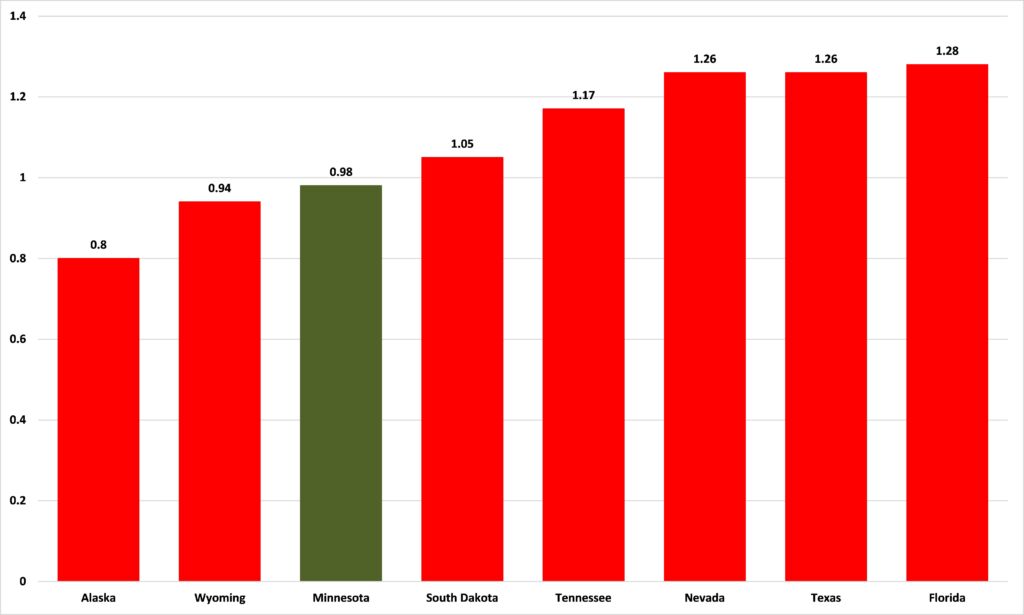What do states without an income tax do?
We at American Experiment have long advocated for cutting Minnesota’s state income taxes. But what about eliminating them entirely?
This weekend, Lori Sturdevant wrote for the Star Tribune that ‘Abolishing state income taxes could be a costly mistake,’ noting that Republican candidate for governor, Scott Jensen, “proposes to phase out the state income tax.” Sturdevant opposes this:
That’s major stuff. Jensen’s plan would gut something that’s been fundamental to government as Minnesotans have known and practiced it for nearly 90 years. It risks significant disruption and damage to the public services people value most, not to mention a shift in the state and local tax burden onto those with less ability to pay.
Would it? It is worth noting that seven states currently have no state income tax. How do they cope?
Figure 1 shows how the seven states with no income tax in 2022 raised their revenues in 2019, the last pre-pandemic year.
Figure 1: State government revenues by source, 2019

Source: Census Bureau and Center of the American Experiment
What is striking is that there is no clear pattern in Figure 1. Alaska relies heavily on Charges and miscellaneous general revenue, a reflection of the contribution of its extractive industries. Nevada, by contrast, relies heavily on Sales and gross receipts tax revenues. Wyoming has more of a balance between funding sources. States without an income tax do not, then, all rely one on other particular source of revenue.
How do these taxes bear on the individuals in these states? Figure 2 shows revenues from each of these sources on a per capita basis for the seven no income tax states, the median for no income tax states, and Minnesota.
Figure 2: State government revenues by source per capita, 2019

Source: Census Bureau, Bureau of Economic Analysis, and Center of the American Experiment
Figure 2 shows that the tax burden on Minnesotans is, on average, higher than in any of the other states except Alaska. This is no surprise, our state is a relatively high tax state. What it also shows, and this is perhaps more surprising, is that individual Minnesotans bear a heavier individual burden of Property, Sales and gross receipts, Corporate income taxes, and Motor vehicle license fees than in the Median state with no income tax. Because of these relatively high burdens across the board, if Minnesota’s revenues from its Individual income tax are eliminated from these numbers, individuals in our state still face a state tax burden greater than individuals in Florida, Nevada, South Dakota, Tennessee, and Texas: five of the seven states without a state income tax.
This might account for why these states are, on average, more appealing to domestic migrants than Minnesota. Figure 3 shows the ratio of domestic in-migrants to out-migrants over the period 2011 to 2019. A ratio less than 1 means that the state lost domestic residents on net and a ratio greater than 1 means that the state gained domestic residents.
Figure 3: Ratio of domestic in-migrants to out-migrants, 2011-2012 to 2018-2019

Source: Internal Revenue Service and Center of the American Experiment
We see in Figure 3 that, while Minnesota lost domestic residents on net over this period, five of the seven states with no income tax gained them. This includes our neighbor South Dakota, which shows that our loss isn’t driven simply by the weather. What this chart shows is that Americans looking for a place to move do not seem to see the no income tax states as ‘hellscapes’.
Scott Jensen’s proposal to eliminate Minnesota’s state income tax is certainly bold. But neither does it mean our state needs to return to the horse and buggy days. Just ask all the Americans moving to states like Florida, Texas, and South Dakota.